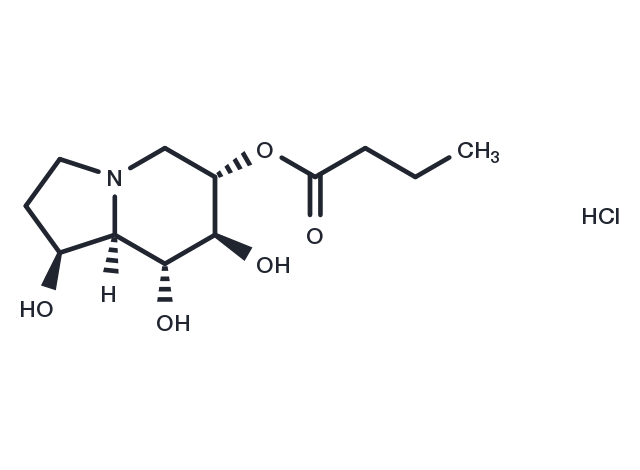Powder: -20°C for 3 years | In solvent: -80°C for 1 year


Celgosivir hydrochloride (MBI 3253 hydrochloride) is an α-glucosidase I inhibitor and inhibits bovine viral diarrhoea virus (BVDV) (IC50: 1.27 μM).

| Pack Size | Availability | Price/USD | Quantity |
|---|---|---|---|
| 2 mg | 5 days | $ 215.00 | |
| 25 mg | 8-10 weeks | $ 1,370.00 | |
| 50 mg | 8-10 weeks | $ 1,790.00 | |
| 100 mg | 8-10 weeks | $ 2,710.00 | |
| 1 mL * 10 mM (in DMSO) | 5 days | $ 485.00 |
| Description | Celgosivir hydrochloride (MBI 3253 hydrochloride) is an α-glucosidase I inhibitor and inhibits bovine viral diarrhoea virus (BVDV) (IC50: 1.27 μM). |
| Targets&IC50 | α-glucosidase I:1.27 μM |
| In vitro | Celgosivir is more effective (IC50: 20 μM) than the parent molecule (IC50: 254 μM) at causing the accumulation of glucosylated oligosaccharides in HIV-infected cells by inhibition of glycoprotein processing. Celgosivir exhibits potent antiviral activity against HIV-1 (IC50: 2.0 μM) [1]. BVDV is a closely related virus of hepatitis C virus (HCV). Celgosivir inhibits BVDV with IC50 values of 16 and 47 μM in plaque assay and cytopathic effect assay, respectively [2]. Celgosivir inhibits DENV2 replication with an EC50 of 0.2 μM. The EC50 values against DENV1, 3, and 4 are less than 0.7 μM [3]. |
| In vivo | During primary infection with a mouse-adapted DENV strain S221, mice show increased viremia on day 3, yet 80% survived day 10 with a virus completely cleared by day 8 [3]. Celgosivir (50 mg/kg, BID for 5 days) fully protects AG129 mice from lethal infection with a mouse-adapted dengue virus and is effective even after 48 h delayed treatment. The protection by celgosivir is dose- and schedule-dependent and that a twice-a-day regimen of 50, 25, or 10 mg/kg is more protective than a single daily dose of 100 mg/kg. Pharmacokinetics studies of celgosivir in mice show that it rapidly metabolizes to castanospermine [4]. |
| Synonyms | MX3253 hydrochloride, MBI 3253 hydrochloride, MDL 28574 hydrochloride |
| Molecular Weight | 295.76 |
| Formula | C12H22ClNO5 |
| CAS No. | 141117-12-6 |
Powder: -20°C for 3 years | In solvent: -80°C for 1 year
H2O: 100 mg/mL (338.11 mM)
DMSO: 100 mg/mL (338.11 mM), Sonification is recommended.
You can also refer to dose conversion for different animals. More
bottom
Please see Inhibitor Handling Instructions for more frequently ask questions. Topics include: how to prepare stock solutions, how to store products, and cautions on cell-based assays & animal experiments, etc.
Celgosivir hydrochloride 141117-12-6 Others MX3253 hydrochloride MBI-3253 Hydrochloride MX-3253 Hydrochloride MX3253 Hydrochloride MDL 28574 Hydrochloride MDL-28574 Hydrochloride MX 3253 Hydrochloride MBI 3253 Hydrochloride MBI 3253 hydrochloride MDL 28574 hydrochloride Celgosivir Hydrochloride MBI3253 Hydrochloride MDL28574 Hydrochloride inhibitor inhibit
